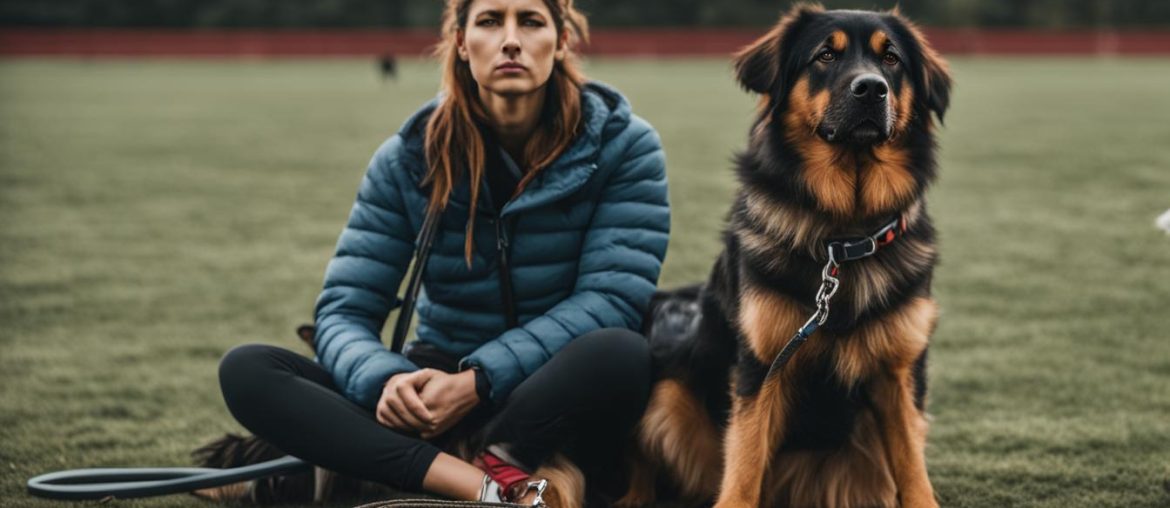When dogs fight, it is important to address the situation and discipline the dogs appropriately. However, it is crucial to approach the discipline in a humane and effective manner. This guide will provide you with strategies and techniques for disciplining your dog after a fight, promoting positive behavior and reducing aggression.
Key Takeaways:
- Understand the importance of remaining calm and avoiding punishment when disciplining a dog after a fight.
- Assess the situation to ensure the safety of all involved and provide any necessary medical care.
- Separate the dogs involved in the fight and create a safe environment to prevent further confrontations.
- Engage in physical activity, such as walking the dogs separately, to release tension and prevent dwelling on the fight.
- Consider seeking professional help from a certified dog trainer or behaviorist for recurring or severe dog fights.
Assess the Situation
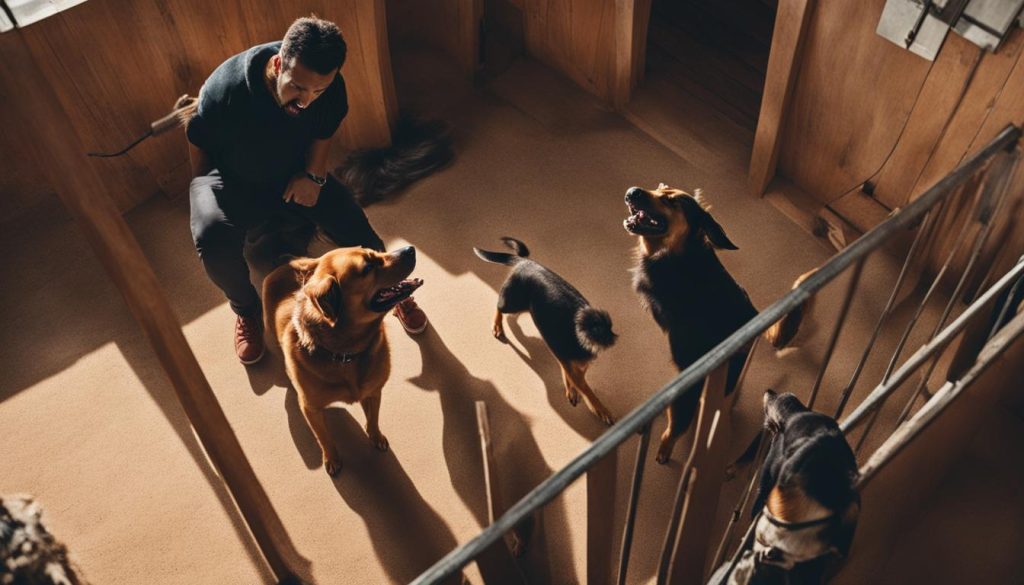
After a dog fight, it is crucial to assess the situation and ensure the safety of all involved. Immediate action is necessary to prevent any further harm. Here are the key steps to follow:
Evaluating the Severity of the Fight
Take a moment to evaluate the severity of the fight. Look for any visible injuries on both dogs, such as bite marks or wounds. If you notice any serious injuries or excessive bleeding, it is important to seek immediate veterinary attention. In some cases, an emergency visit may be necessary to address the injuries properly.
Separating the Dogs
If the fight is less severe and there are no significant injuries, it is still important to separate the dogs involved. You can use physical barriers like baby gates or crates to keep them apart. This helps prevent any further confrontations and gives them a chance to calm down.
Ensuring Safety
During the separation, make sure the dogs are in a safe environment. Remove any objects or resources that may trigger another fight, such as toys or food bowls. Keep a close eye on their behavior and avoid situations that may lead to aggression.
Remember, every dog fight situation is unique, and it’s essential to use your judgment in assessing the severity and ensuring the safety of everyone involved.
Remain Calm and Avoid Punishment
When dealing with a dog after a fight, it is of utmost importance to remain calm and composed. Reacting with punishment, shouting, or aggressive behavior can exacerbate the situation and create fear or anxiety in the dogs. Instead, discipline should focus on promoting a calm and positive environment.
Avoiding punishment does not mean ignoring the behavior altogether. It means finding alternative ways to redirect your dog’s attention and reinforce positive behavior. Positive reinforcement techniques, such as rewarding good behavior with treats or praise, can be effective in encouraging desired actions and behaviors.
Creating a calm environment is also essential for post-fight recovery. Provide a safe and quiet space for your dog, away from any potential triggers or stressors. Minimize noise and distractions to help your dog feel secure and relaxed. Additionally, maintaining a consistent routine and engaging in calming activities, such as gentle walks or interactive play, can help promote a sense of stability and reduce anxiety.
Remember, disciplinary actions should be focused on teaching and guiding your dog, rather than instilling fear. Through patience, consistency, and positive reinforcement, you can help your dog recover from a fight and promote a harmonious relationship.
“Discipline should focus on promoting a calm and positive environment, rather than instilling fear.”
Post-Fight Medical Care for Dogs: Ensuring Their Well-being
After a dog fight, it is crucial to attend to any injuries and provide the necessary medical care for your furry companions. Assessing the extent of the physical damage is essential in determining the appropriate course of action. It is always advisable to consult a veterinarian for professional advice and treatment, especially if the injuries are severe or if you are unsure about the extent of the damage.
When examining the dogs for injuries, it is important to handle them with care and ensure their safety during the process. Take note of any visible wounds, such as bite marks or lacerations, and check for signs of pain or discomfort. If you notice any swelling, bleeding, or other concerning symptoms, it is essential to seek immediate veterinary attention to prevent further complications.
Depending on the severity of the injuries, the veterinarian may recommend various treatments, such as cleaning and disinfecting wounds, suturing, administering antibiotics, or providing pain medication. Follow their guidance closely to ensure the best possible care for your dogs. Additionally, they may also advise you on any necessary precautions to take during the recovery period, such as restricting physical activity or implementing a special diet.
“Attending to your dog’s injuries promptly and seeking professional help when needed is crucial in ensuring their well-being and a speedy recovery,” says Dr. Amanda Smith, a renowned veterinarian with years of experience in handling post-fight medical care for dogs. “Remember to observe your dog closely during the recovery process and alert your veterinarian of any changes in behavior or signs of infection.”
Providing post-fight medical care not only addresses the physical well-being of your dogs but also promotes their emotional and psychological recovery. It is important to create a calm and soothing environment for them during this time and offer plenty of love, attention, and reassurance as they heal. With proper medical care, support, and your unwavering commitment, your dogs can bounce back from a fight and regain their overall health and happiness.
| Tips Post-Fight Medical Care for Dogs |
|---|
| Assess the extent of the injuries and seek veterinary advice if needed. |
| Handle your dogs with care during the examination process. |
| Observe for visible wounds, swelling, bleeding, or concerning symptoms. |
| Follow the veterinarian’s recommended treatments and precautions. |
| Create a calm and soothing environment for your dogs during their recovery. |
Separate The Dogs
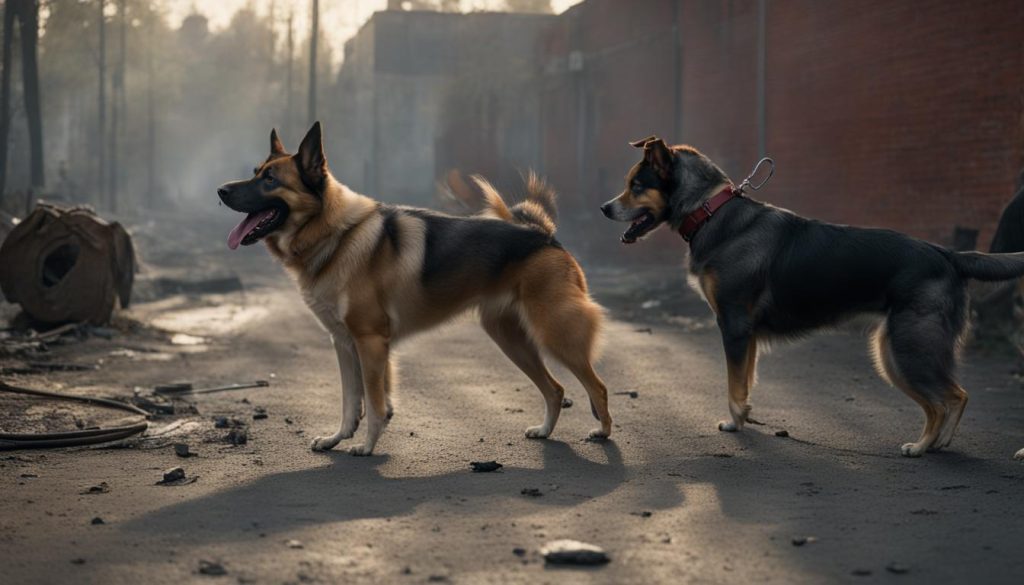
After a fight, it is advisable to separate the dogs involved for a period of time. This allows them to calm down and prevents any further tension or confrontations. Create a safe and comfortable environment for each dog, providing them with their own space and resources to avoid triggering another fight.
Creating physical barriers between the dogs can help reinforce the separation and reduce the risk of any potential confrontations. This can be done by using baby gates, crates, or separate rooms. Ensure that each dog has access to food, water, and a comfortable resting area.
Creating a Safe Environment
- Remove any potential triggers or resources that may lead to another fight, such as toys, food bowls, or high-value items.
- Keep the dogs on a leash and separate them when necessary, especially during feeding time or when visitors are present.
- Provide mental and physical stimulation for each dog individually to prevent boredom and reduce excess energy.
“It is crucial to create a safe environment for both dogs to prevent any potential confrontations. By separating them and removing triggers, you can minimize the risk of another fight and promote a peaceful living situation.” – Canine Behavior Expert
Preventing Further Confrontations
While keeping the dogs separated is important, it is also necessary to address the underlying causes of the fight to prevent future confrontations:
- Identify any potential triggers or stressors that may have led to the fight and work on minimizing or eliminating them.
- Implement positive reinforcement training techniques to reinforce desirable behavior and promote a harmonious relationship between the dogs.
- Seek professional help from a certified dog trainer or behaviorist if the dogs continue to exhibit aggressive behavior or if the fights persist.
| Preventing Further Confrontations | Key Strategies |
|---|---|
| Identify triggers and stressors | Minimize or eliminate them |
| Positive reinforcement training | Reinforce desirable behavior |
| Seek professional help | Consult with a certified dog trainer or behaviorist |
Get Your Dogs Moving

After a dog fight, it is important to engage your dogs in physical activity to help them release energy and prevent dwelling on the fight. Walking the dogs separately is a great way to accomplish this. Not only does it provide exercise, but it also allows each dog to have its own space and time away from the other. Walking also helps to redirect their focus and provide mental stimulation, which can be beneficial in reducing tension and promoting a more relaxed state.
When walking your dogs separately, it is important to keep a safe distance between them to avoid any potential triggers or confrontations. Use separate leashes and choose different routes to ensure a safe and peaceful walk. Additionally, it is advisable to consider using muzzles if necessary, especially if the dogs have a history of aggression or if their behavior is unpredictable.
Engaging your dogs in physical activity after a fight not only helps them release built-up tension but also promotes a healthier and more balanced state of mind. It is important to remember that consistency and patience are key when implementing this practice. By providing separate walks and opportunities for exercise, you can prevent your dogs from dwelling on the fight and increase their overall well-being.
Benefits of Physical Activity After a Dog Fight:
- Helps release energy and reduce tension
- Provides mental stimulation and redirection of focus
- Promotes a healthier and more balanced state of mind
- Prevents dwelling on the fight and reduces the chances of further confrontations
Tips for Walking Dogs Separately:
- Use separate leashes to maintain control
- Choose different routes to provide individual space
- Keep a safe distance between the dogs to avoid triggers
- Consider using muzzles if necessary
- Stay consistent and patient with the practice
| Walking Dogs Together | Walking Dogs Separately |
|---|---|
| Can lead to tension and triggers | Provides individual space and avoids confrontations |
| Increases the risk of further fights | Reduces the chances of future confrontations |
| May cause heightened anxiety and reactivity | Promotes a more relaxed and calmer state of mind |
Seek Professional Help
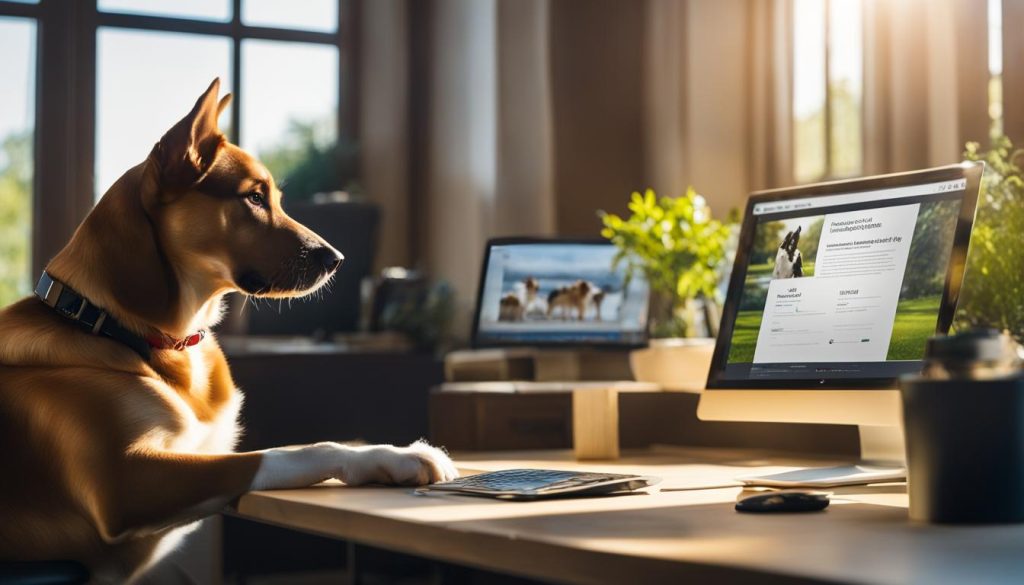
If you find that dog fights are recurrent or severe, it is highly recommended to seek professional help from a certified dog trainer or a behaviorist. These experts have extensive knowledge and experience in understanding dog behavior and can provide specialized guidance tailored to your dog’s needs.
A certified dog trainer can assess the underlying causes of aggression and design a behavior modification plan that focuses on positive reinforcement and effective discipline techniques. They can teach you practical strategies to manage and correct your dog’s behavior, promoting a harmonious environment for both you and your furry companion.
Consulting a behaviorist is particularly beneficial in complex cases where the aggression stems from deeper issues such as fear, anxiety, or trauma. Behaviorists have advanced training in animal behavior and psychology, allowing them to delve into the root causes of aggression and provide targeted interventions to help modify your dog’s behavior.
Choosing the Right Professional
When seeking professional help, it is important to choose a certified dog trainer or behaviorist who has experience working with aggression and dog fights. Look for professionals who use positive reinforcement techniques and have a thorough understanding of canine behavior. Inquire about their training methods and ensure they prioritize your dog’s safety and well-being.
Additionally, consider seeking recommendations from reputable sources such as veterinarians or trusted dog owners. Reading reviews and testimonials can also provide insights into the effectiveness and professionalism of a dog trainer or behaviorist.
| Benefits of Seeking Professional Help | Drawbacks of Not Seeking Professional Help |
|---|---|
|
|
Rebuilding the Relationship Between Dogs After a Fight
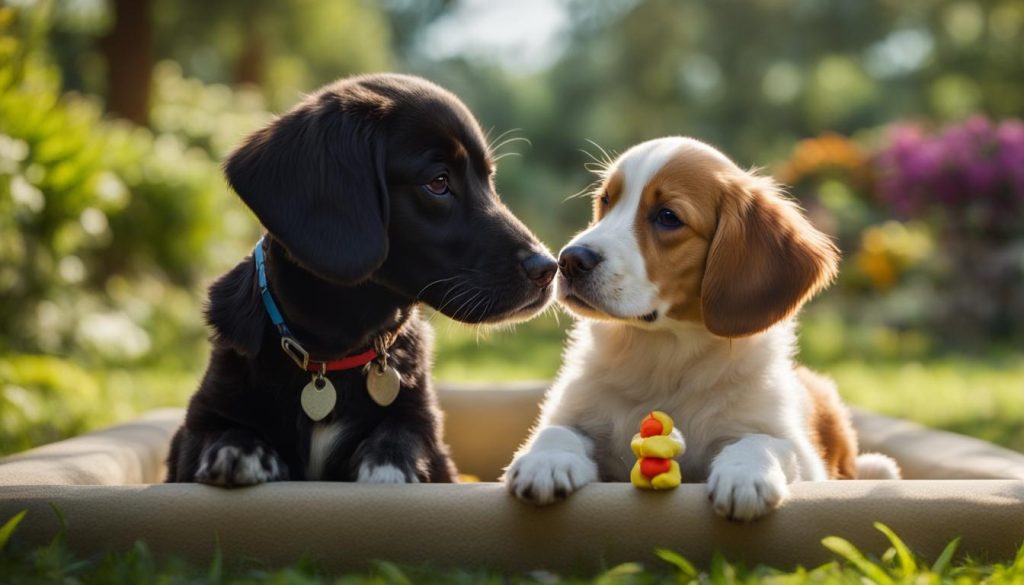
After a dog fight, it is essential to take steps to rebuild the relationship between the dogs involved. Reintroducing them gradually and under supervised interactions is key to promoting a harmonious environment. Here are some strategies to help facilitate the process:
1. Create a Neutral Environment
When reintroducing the dogs, choose a neutral space that is free from triggers or associations with the previous fight. This can help reduce tension and prevent any lingering aggression. Avoid areas where the fight occurred and ensure that both dogs have enough space to move around comfortably.
2. Use Positive Reinforcement
During the reintroduction process, use positive reinforcement techniques to reward calm and peaceful behavior. This can include treats, praise, or playtime. By associating positive experiences with each other’s presence, the dogs can gradually rebuild trust and form positive associations.
3. Keep Interactions Short and Supervised
Initially, keep the interactions between the dogs short and closely supervised. This allows you to intervene if any signs of aggression or tension arise. Gradually increase the duration of the interactions as the dogs become more comfortable with each other. Monitor their body language for any signs of stress or discomfort.
| Signs of Stress in Dogs | Signs of Comfort in Dogs |
|---|---|
|
|
It is important to note that the reintroduction process may take time and patience. Each dog will progress at their own pace, and it is crucial to respect their individual boundaries and comfort levels. Rushing the process can lead to more conflicts and setbacks.
By following these steps and providing a supportive and controlled environment, you can help the dogs rebuild their relationship after a fight. Remember to always prioritize the safety and well-being of both dogs throughout the entire process.
Understanding Why Dogs Fight
There are several reasons why dogs engage in fights, and understanding these causes is crucial in preventing future incidents. Please be aware that aggression in dogs can stem from various factors, including genetic predispositions, same-sex aggression, resource guarding, rivalry between younger and older dogs, fear reactivity, and issues related to dog parks and socialization.
Genetic Factors
Genetics play a significant role in a dog’s behavior and temperament. Some breeds are more prone to aggression due to their breeding history or inherent instincts. Understanding the breed characteristics and potential genetic predispositions can help owners take proactive measures to prevent aggression and address it effectively if it arises.
Same-Sex Aggression
Same-sex aggression occurs when dogs of the same gender display aggressive behavior towards one another. This type of aggression is often territorial or driven by a desire to establish dominance. It is important to be cautious when introducing dogs of the same sex and to monitor their interactions closely to prevent fights.
Resource Guarding
Resource guarding is a common cause of dog fights and occurs when dogs become possessive over their food, toys, or other valuable items. This behavior can escalate quickly if not managed properly. Training dogs to share resources and implementing strategies to prevent resource guarding can help minimize the risk of fights.
Rivalry Between Younger and Older Dogs
Dogs of different ages may engage in fights due to a power struggle or hierarchy-related issues. Younger dogs may challenge older dogs for dominance, leading to aggression. It is important to establish clear boundaries and rules within the household and provide appropriate training and socialization for dogs of all ages.
Fear Reactivity
Fear reactivity occurs when a dog becomes aggressive as a response to a perceived threat or fear-inducing stimuli. Dogs that have not been properly socialized or have had negative experiences in the past may exhibit fear-based aggressive behaviors. Addressing fear and anxiety in dogs through positive reinforcement training and desensitization techniques can help mitigate the risk of fights.
Dog Parks and Socialization Issues
Dog parks and socialization settings can sometimes be breeding grounds for fights, especially if dogs are not properly socialized or have not learned appropriate behavior around other dogs. Lacking social skills or encountering unfamiliar or poorly behaved dogs can lead to tense situations and potential fights. It is important for owners to supervise their dogs closely, provide adequate socialization opportunities, and be mindful of their dog’s behavior in social settings.
In summary, understanding the reasons behind dog fights is essential in preventing future incidents. Genetic factors, same-sex aggression, resource guarding, rivalry between younger and older dogs, fear reactivity, and issues related to dog parks and socialization can all contribute to aggressive behavior in dogs. By recognizing and addressing these underlying causes, owners can take proactive measures to prevent fights and ensure the safety and well-being of their canine companions.
Preventing Dog Fights: Recognizing Signs of Aggression and Understanding Dog Body Language
Preventing dog fights is essential for the safety and well-being of both dogs and humans. By recognizing the signs of aggression and understanding dog body language, we can proactively intervene and diffuse potentially dangerous situations. Dogs communicate through their body language, and being able to interpret these signals is key in preventing conflicts and promoting harmony.
Signs of Aggression: Dogs display various signs of aggression, including growling, bared teeth, raised hackles, and stiff body posture. They may also exhibit dominant behavior such as standing tall, direct staring, and snarling. Please be aware that aggression can be directed towards other dogs, animals, or humans, and it can stem from fear, territoriality, resource guarding, or social dominance.
Understanding Dog Body Language: Dogs use their body language to communicate their intentions and emotions. Bites are often preceded by a series of warning signals that we may overlook if we’re not familiar with them. Examples of these signals include lip licking, yawning, avoidance, and tense body posture. Tail position, ear position, and eye contact also hold valuable clues about a dog’s emotional state.
| Signs of Aggression | Understanding Dog Body Language |
|---|---|
| – Growling | – Lip licking |
| – Bared teeth | – Yawning |
| – Raised hackles | – Avoidance |
| – Stiff body posture | – Tense body posture |
| – Dominant behavior (e.g., direct staring, snarling) | – Tail position |
It is important to remember that each dog is an individual, and their body language may vary. Some dogs may exhibit more subtle warning signs, while others may display overt aggression. By observing and understanding your own dog’s unique body language, you can better anticipate and prevent potential conflicts.
Preventing dog fights requires vigilance and proactive intervention. When encountering potentially tense situations, it’s important to take immediate action. This can involve calmly redirecting your dog’s attention, creating distance between dogs, or removing your dog from the situation altogether. Seeking professional help, such as consulting a certified dog trainer or behaviorist, can also provide valuable guidance and support in preventing dog fights.
By staying educated about the signs of aggression and dog body language, we can create a safer environment for our furry companions. Taking proactive measures and addressing potential conflicts early on not only prevents physical harm but also promotes a harmonious relationship between dogs and enhances overall well-being.
How To Break Up A Dog Fight
Knowing how to safely and effectively break up a dog fight is crucial in maintaining the safety of all involved. When faced with a dog fight, it is important to prioritize safety and take immediate action. Here are some steps you can take:
- Ensure Safety: Before intervening, make sure you are not putting yourself at risk. Avoid putting your hands near the dogs’ mouths or directly intervening physically if it’s not safe to do so.
- Use Physical Barriers: If possible, use physical barriers such as a large board, a piece of plywood, or a sturdy object to separate the dogs. This can help create distance and prevent further injuries.
- Distract the Dogs: Try to distract the dogs by making a loud noise, using a loud whistle, or using a spray bottle filled with water. This can redirect their attention and create an opportunity to separate them.
- Seek Assistance: If the situation is escalating or you are unable to safely separate the dogs, seek assistance from others. This can include asking for help from bystanders or contacting your local animal control for assistance.
Remember, breaking up a dog fight can be dangerous, and it is important to prioritize safety above all else. If you are unsure or uncomfortable with intervening, it is best to seek professional help from a trained dog behaviorist or animal control.
Wrapping Up
Disciplining a dog after fighting requires a careful and measured approach. It is important to remain calm, prioritize safety, and provide appropriate medical care after a fight. Separating the dogs and seeking professional help if needed are also essential steps in disciplining and managing dog behavior. By understanding the reasons behind dog fights and taking preventive measures, we can promote a peaceful and harmonious environment for our canine companions.
When addressing a dog’s behavior after a fight, it is crucial to approach discipline with patience and understanding. Maintaining a calm demeanor helps create a positive environment and prevents further aggression. Prioritizing safety ensures the well-being of all involved and minimizes the risk of future conflicts.
After a fight, it is important to carefully assess any physical injuries and provide appropriate medical care. Prompt attention to wounds and consultation with a veterinarian are necessary to prevent complications and promote healing. Additionally, separating the dogs involved allows them to calm down and prevents further confrontations.
In cases where dog fights are recurrent or severe, seeking professional help from a certified dog trainer or behaviorist is highly recommended. These experts can assess the underlying causes of aggression and provide specialized guidance tailored to your dog’s needs. They can assist in designing a behavior modification plan and teaching practical techniques to discipline and manage your dog’s behavior effectively.
FAQ
How should I discipline my dog after a fight?
It is crucial to approach discipline in a humane and effective manner. Avoid punishment, shouting, or aggressive behavior. Focus on promoting a calm and positive environment.
What should I do immediately after a dog fight?
Assess the situation and ensure the safety of all involved. Separate the dogs using physical barriers if necessary. Evaluate the severity of the fight, look for injuries, and determine if medical attention is needed.
Are there any specific steps to follow after a dog fight?
Yes. Check for injuries or wounds that may require immediate medical attention. Separate the dogs involved for a period of time to allow them to calm down. Get the dogs moving, preferably by walking them separately, and consider using muzzles if necessary.
When should I seek professional help after a dog fight?
If dog fights are recurrent or severe, it is highly recommended to consult a certified dog trainer or behaviorist. They can assess the underlying causes of aggression and provide specialized guidance.
How can I rebuild the relationship between dogs after a fight?
Gradual and supervised interactions should be initiated. Allow the dogs to become familiar with each other again, ensuring their safety and well-being.
What are the reasons behind dog fights?
Dog fights can be caused by various factors, including genetic predispositions, same-sex aggression, resource guarding, rivalry between younger and older dogs, fear reactivity, and issues related to dog parks and socialization.
How can I prevent dog fights?
By recognizing the signs of aggression and understanding dog body language, you can take proactive measures to prevent dog fights. Being observant and educated about dog behavior is key.
What should I do to break up a dog fight?
It is important to prioritize safety. Use physical barriers, distraction methods, and seek assistance from others if needed. Knowing how to safely and effectively intervene is crucial.


